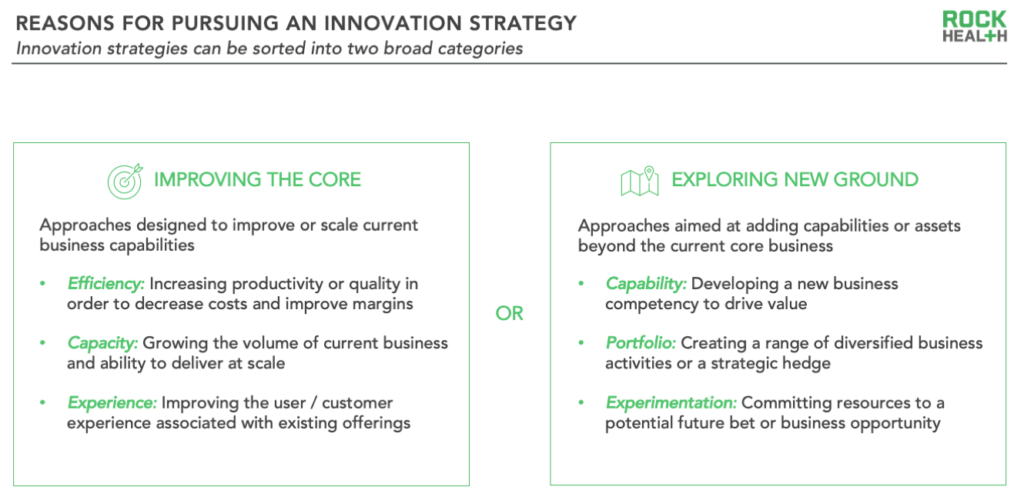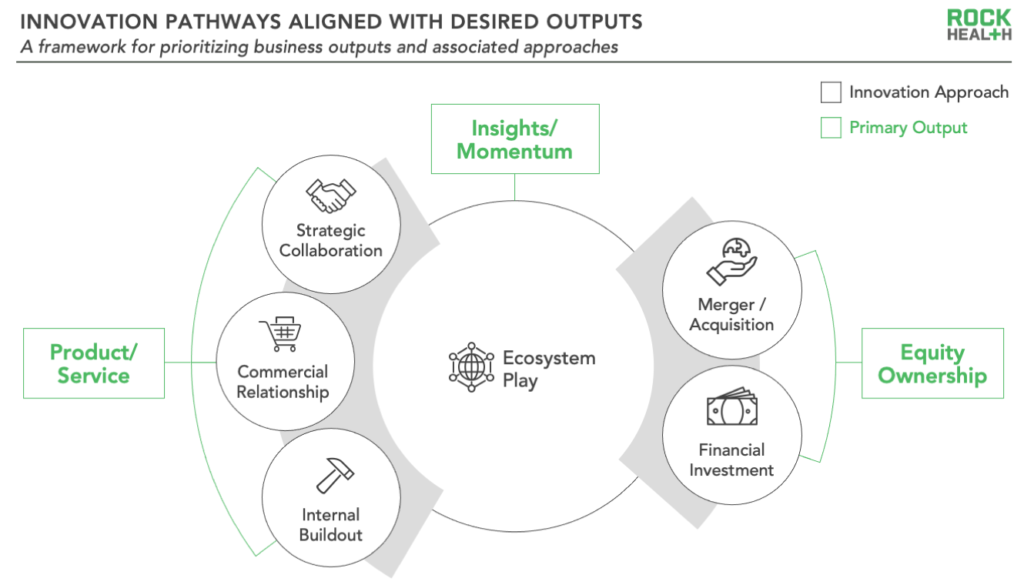Easy is hard: A back-to-basics approach for succeeding in uncertain times
In uncertain times, innovators create silver linings rather than waiting out the storm. Our latest takes on market corrections, economic question marks, and evidence of clinical impact becoming table stakes should not be mistaken for warning to hunker down. Rather, industry leaders should continue to make big plays—where there’s uncertainty, there’s opportunity. In this piece, we’ll unpack this call to action and show how healthcare incumbents, enterprises entering healthcare, and mature startups can navigate digital health’s choppy waters using a back-to-basics framework to guide bold moves.
Innovation 101: Go back to the basics
We sometimes hear from leaders itching to take immediate action. However, speed shouldn’t come at the expense of thoughtful analysis and clear decision making—winning requires a structured approach to strategy and innovation. Before jumping into debates about specific tactics (“What if we start a corporate venture capital fund?” or “Should we build in-house, find a partner, or acquire a company?”), organizations should step back and reflect upon a set of timeless, simple—but not easy—strategic questions:
- What do we want to accomplish?
- How should we go about doing it?
- Who do we need to help us?
In this post, we focus on the top two questions (what and how) to lay a foundation for the approach and share principles that apply across organizations. Partnership decisions (who) are packed with nuance—which can be tackled once a clear direction is set.
First things first: What do we want to accomplish?
The first strategic decision to make is: Are you focused on improving the core or exploring new ground? You can think of “the core” as improvements to current-state efficiency, capacity, and/or customer experience. For example, Novant Health is leveraging Aidoc’s platform to reduce emergency department length of stay. Conversely, “new ground” refers to approaches that add new capabilities, diversify the company’s portfolio, and/or enable experimentation, such as Best Buy’s expansion into remote patient monitoring via acquisition of Current Health. In some cases, these objectives (improving the core and exploring new ground) may be pursued in parallel—but it’s useful to categorize innovation approaches based on their proximity to current business. The distinction will help your organization get clear on expected ROI timelines, ringfence the necessary team and resources, and define the projected impact on day-to-day operations vs. future growth.

The next-order strategic decision: What specific business outputs is your organization hoping to achieve? As the Cheshire Cat told Alice, “If you don’t know where you’re going, any road can take you there.” You can begin by identifying which one of three desired outcomes—products / services, insights / momentum, or equity ownership—the strategy is meant to achieve.
- Product / Service: solutions to meet internal needs or external offerings for customers
- Insights / Momentum: opportunities to share knowledge, build relationships, or generate new ideas
- Equity Ownership: ownership of an asset, equity stake, or company, with the associated potential for control or financial upside
Next up: How should we go about doing it?
Based on your decisions around desired outputs (the what), you can begin evaluating the various pathways (the how) that lead to each. Several trails can take you to the metaphorical mountaintop of your choice, but understanding your option set is a good start.

Product / Service: Strategic collaborations may be right for your company if you’re seeking custom solution development and/or shared risk, and you’re able to bring complementary capabilities to the table (e.g., Sanofi’s digital companion partnership with BrightInsight). On the other hand, commercial relationships might be a good fit if your team is looking for an off-the-shelf solution and can allocate implementation and vendor management resources (e.g., Walmart’s use of Epic medical records). You may also decide to build internally if the new offering represents a unique differentiator, and your company has the requisite in-house combination of budget, time, and human capital to execute successfully (e.g., Roche’s launch of the Navify platform).
Insights / Momentum: If your company’s primary goal is to spark new ideas, form business relationships, or facilitate knowledge exchange, the right approach might include ecosystem plays, such as incubators, accelerators, innovation centers, and/or pitch competitions. Notably, these moves can also feed into the other desired outputs—in both organic and curated ways. For instance, participating in an accelerator program may catalyze a future equity investment opportunity. When going down the ecosystem path, it’s important to recognize that the ROI of these activities may be much harder to calculate, but the value is (or can be) real. As an example, Johnson & Johnson has generated a deal (i.e., an investment, research agreement, or partnership) with over 200 of the companies participating in JLABS.
Equity Ownership: An M&A approach may be right if you’re aiming to generate revenue / cost efficiencies, acqui-hire pre-built teams, integrate a suite of complementary offerings, or quickly capture market share. For example, DarioHealth completed a series of acquisitions (Physimax, Upright, and wayForward) to expand the capabilities and therapeutic breadth of its chronic care platform. In addition to significant capital commitment, pre-transaction diligence and post-transaction integration are key inputs for any decision to merge or acquire. Financial investments into privately held companies may be preferred if your organization is looking to place multiple bets on potential futures or capture upside from strategic partnerships. Check sizes are typically smaller for this kind of investing, which can make it more attractive, but the investor also maintains far less control. As an example, Children’s Hospital of Philadelphia (CHOP) invested $50M into spinout Spark Therapeutics, generating a $456M payoff for approximately 11% of the company.
Riding the waves of change
Innovation feels different these days. Markets are shifting—and expectations around clinical robustness, ROI, and profitability are changing, too. To get ahead in this environment of headline-worthy triumphs and missteps, companies need to rely on thoughtful and deliberate analysis. That starts with asking simple (but challenging) questions to clearly define strategy, objectives, and desired business outputs. With this overarching vision in place, organizations can chart how they intend to reach their goals and assess which partners to take on the journey. Companies that put in the work to bring structure to their innovation approach will be able to take advantage of the unique opportunities created by today’s uncertain waters.
Rock Health Consulting works with enterprise companies on digital health strategy and innovation. For more information, reach out to advisory@rockhealth.com.


